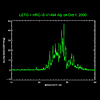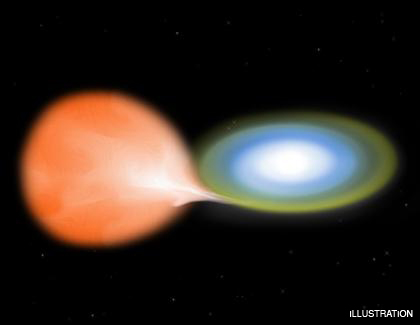Chandra Discovers Eruption and Pulsation in Nova Outburst
Chandra observed Nova Aquilae, an outburst caused by a thermonuclear explosion on the surface of a white dwarf star, four times from April 2000 through October 2000. In the October data astronomers detected a dramatic flare of X-rays and cyclical 40-minute pulsations - the first time either of these phenomena had been seen in X-rays. The pulsations are thought to come from the contraction and expansion of the outer layers of the white dwarf, but the cause of the 15 minute X-ray flare remains a mystery.
The artist's illustration depicts a classical nova binary system just before an explosion on the surface of the white dwarf. Classical novas occur in a system where a white dwarf closely orbits a normal, companion star. In this illustration, gas is flowing from the large red,companion star into a disk and then onto the white dwarf that is hidden inside the white area. As the gas flows ever closer to the white dwarf, it gets increasingly hotter, as indicated by the change in colors from yellow to white. When the explosion occurs, it engulfs the disk of gas and the red companion star.
|
||||||||||||||||||||
This is an artist's illustration featuring a white dwarf star named Nova Aquilae and its red companion star. The star is depicted with orange colors, and the area around the white dwarf in white, blue and green hues. The white dwarf star is the remnant of a Sun-like star that has exhausted its nuclear fuel and shed its outer layers, leaving behind a dense core composed primarily of carbon and oxygen. Classical novas occur in a system where a white dwarf closely orbits a normal, companion star. In the illustration, gas is flowing from the large red companion star into a disk and then onto the white dwarf that is hidden inside the white area. As the gas flows ever closer to the white dwarf, it gets increasingly hotter, as indicated by the change in colors from yellow to white. When the explosion occurs, it engulfs the disk of gas and the red companion star.





